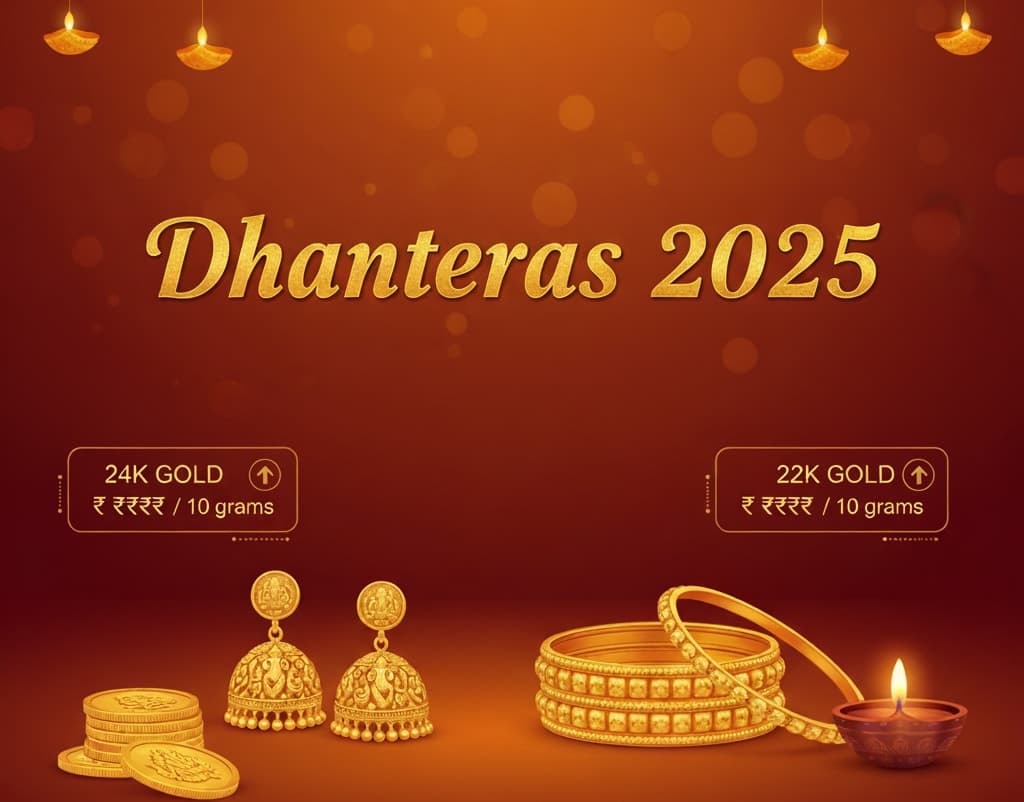Planning to buy gold this Dhanteras 2025? You're not alone—millions across India will purchase gold on October 18, 2025 (Saturday) to celebrate this auspicious festival. But with gold prices at all-time highs, knowing the current rates, best buying times, and smart shopping strategies can save you thousands of rupees.
This complete guide covers everything you need: today's gold rates across major cities, the best muhurat timing for purchases, five-year price trends, and expert tips to get maximum value for your money.
When is Dhanteras 2025? Date and Best Time to Buy Gold
Dhanteras Date 2025: Saturday, October 18, 2025
Diwali 2025: Tuesday, October 21, 2025
Best Muhurat Timings for Gold Purchase
The most auspicious time to buy gold on Dhanteras 2025:
Prime Time: 7:31 PM to 9:29 PM (Vrishabha Kaal)
This 2-hour window is considered the absolute best time for gold purchases. Buying during this period is believed to bring lasting prosperity to your home.
Good Time: 5:54 PM to 8:22 PM (Pradosh Kaal)
This evening period right after sunset is also highly auspicious for purchasing gold and silver.
Avoid: 12:15 PM to 1:45 PM (Rahu Kaal)
Do not make any major purchases during this inauspicious period on Dhanteras day.
Diwali Gold Rate History: Last 5 Years Price Trends
Understanding how gold prices changed during previous Diwali seasons helps you make smarter buying decisions:
Year | Diwali Date | 24K Gold Price | Year-on-Year Change | % Change |
|---|---|---|---|---|
2020 | Nov 14 | ₹51,043 | — | — |
2021 | Nov 4 | ₹47,674 | -₹3,369 | -6.60% |
2022 | Oct 24 | ₹50,625 | +₹2,951 | +6.19% |
2023 | Nov 12 | ₹60,746 | +₹10,121 | +19.99% |
2024 | Nov 1 | ₹79,143 | +₹18,397 | +30.27% |
Key Insights from 5-Year Gold Price Data
Overall Growth: Gold prices increased by ₹28,100 (55%) from Diwali 2020 to 2024—significantly outpacing inflation and bank fixed deposits.
Recent Surge: The biggest jump happened between Diwali 2023 and 2024 (30.27% increase), driven by global economic uncertainty, geopolitical tensions, and rupee depreciation.
Investment Returns: Someone who bought ₹1 lakh worth of gold on Dhanteras 2020 would see it valued at approximately ₹1.55 lakh by Diwali 2024.
2025 Prediction: With current rates at ₹1,23,000+, gold is expected to stay elevated through 2025, with experts forecasting ₹1,36,000-₹1,44,000 by year-end.
Why Buy Gold on Dhanteras? Cultural & Financial Significance
Religious Importance
Dhanteras marks the day Goddess Lakshmi emerged from the cosmic ocean carrying gold, making it the most auspicious day for purchasing precious metals. Buying gold on this day is believed to:
Invite wealth and prosperity into your home
Bring blessings from Goddess Lakshmi
Protect family members from negative energies
Ensure long-term financial stability
The tradition of lighting lamps alongside gold purchases honors the legend where gold's brilliance saved a prince from death, symbolizing protection and prosperity.
Investment Benefits
Beyond tradition, gold serves as:
Inflation Hedge: Gold typically maintains value during economic uncertainty
Portfolio Diversification: Reduces overall investment risk
Liquidity: Easy to sell when cash is needed
Generational Wealth: Can be passed down as inheritance
Crisis Protection: Performs well when other investments decline
Factors driving gold prices toward Dhanteras 2025 record highs
Multiple converging forces pushed gold to unprecedented territory as the 2025 festival season approached. International spot gold surpassed $4,000 per troy ounce for the first time on October 7, 2025, reaching a peak of $4,059.04 on October 8—a psychological barrier that demonstrated gold's renewed safe-haven appeal amid global uncertainty.
The U.S. Federal Reserve's pivot to rate cuts, beginning with a 50-basis-point reduction in September 2025 and expectations for an additional 100 basis points by year-end, reduced the opportunity cost of holding non-yielding gold. Lower interest rates make gold more attractive compared to bonds and savings deposits, driving investment demand. The weakening U.S. dollar—down approximately 10% in 2025—further boosted gold prices for international buyers while adding 3-5% to India's domestic price increases due to currency translation effects.
The rupee's depreciation to ₹88.68-88.79 per USD as of October 2025 (down 3.69% year-to-date) amplified the impact for Indian buyers. When international gold rises in dollar terms and the rupee simultaneously weakens, domestic prices face double pressure. Bank of Baroda forecasts the rupee trading near ₹89.05 by late 2025, suggesting continued currency headwinds for Indian gold prices.
Geopolitical tensions provided sustained support. The ongoing Russia-Ukraine conflict, Middle East instability, and U.S.-China trade tensions under the Trump administration created continuous uncertainty that drove investors toward gold's perceived safety. Central banks globally added over 1,000 tonnes of gold annually from 2022-2024 as they diversified away from dollar reserves. India's Reserve Bank alone accumulated 72.6 tonnes in 2024, though it slowed to just 3.8 tonnes in the first eight months of 2025.
Domestically, India's gold imports surged to $5.2 billion in August 2025, marking a 37% month-on-month increase and the highest volume (60-65 tonnes) since November 2024. This import surge ahead of festival season signaled strong anticipated demand despite record prices. The reduction of import duties from 15% to 6% in July 2024 made gold relatively more accessible, though prices rose far more than this duty cut reduced them.
Festive demand patterns historically add 2-5% to prices during the Dhanteras-Diwali window, though in 2025 this seasonal premium remained muted as existing price levels already stretched affordability. Investment demand for gold bars and coins notably outpaced jewelry purchases, as buyers sought to capture gold's appreciation while minimizing the additional cost burden of making charges.
Best Ways to Buy Gold This Dhanteras 2025
1. Gold Jewelry
Best For: Traditional buyers who want wearable gold
Purity: 22 karat (91.6% pure gold)
Cost: Base price + 5-25% making charges + GST
Pros:
Fulfills cultural tradition
Can be worn on special occasions
Tangible asset you can see and hold
Cons:
Highest total cost due to making charges
Resale value is 60-85% of purchase price
You lose making charges when selling
2. Gold Coins (Most Recommended)
Best For: Investment-focused buyers
Purity: 24 karat (99.9% pure gold)
Cost: Base price + minimal charges (₹50-200) + GST
Pros:
Lowest making charges
Easy to store and verify
Retains 95-99% value on resale
Available in 1g, 2g, 5g, 10g denominations
BIS hallmarked for authenticity
Cons:
Cannot be worn as jewelry
Requires secure storage
Recommended: Buy from banks, MMTC-PAMP, or established jewelers with BIS certification.
3. Digital Gold
Best For: Tech-savvy buyers and small investors
Minimum Investment: ₹1
Platforms: Paytam, Google Pay, PhonePe, Tanishq Digital Gold
Pros:
Start with just ₹1
No storage worries
No making charges
Instant buying and selling 24/7
Can convert to physical gold
Cons:
Cannot be used for puja rituals
No physical possession
Platform dependency
4. Sovereign Gold Bonds (SGB)
Best For: Long-term investors (5-8 years)
Special Benefit: 2.5% annual interest + gold price appreciation
Pros:
Government-backed security
Earn interest on gold
Tax-free returns if held till maturity
No storage needed
Cons:
8-year lock-in (can exit after 5 years)
Not suitable for short-term needs
Cannot be used for traditional purposes
Understanding Gold Pricing: Making Charges & GST Explained
How to Calculate Total Gold Cost
Formula: Base Gold Price + Making Charges + GST (3% on gold + 5% on making) = Final Price
Example: 10-gram gold necklace (22K) in Mumbai
Base gold price: ₹1,12,900
Making charges (12%): ₹13,548
GST on gold (3%): ₹3,387
GST on making (5%): ₹677
Total Cost: ₹1,30,512
Making Charges: What's Reasonable?
Simple designs: 5-10%
Moderate designs: 10-15%
Complex/bridal jewelry: 15-20%
Over 20%: Avoid—too expensive
Smart Tip: Making charges are negotiable! Compare 3-5 jewelers and bargain on this component.
How BIS Hallmarking Protects You
Since 2021, all gold jewelry in India must carry BIS hallmark with these 5 marks:
BIS logo (triangle)
Purity grade (916 for 22K, 750 for 18K)
HUID code (6-digit unique number)
Assaying center mark
Jeweler identification
Verification Steps:
Check all 5 marks are clearly stamped on jewelry
Download "BIS Care" app
Enter HUID code to verify authenticity online
Confirm jeweler is BIS-registered at bis.gov.in
Red Flag: If HUID doesn't verify online or jeweler isn't registered, do not buy!
Verifying authenticity through BIS hallmarking in the digital age
Since June 2021, BIS hallmarking became mandatory for all gold jewelry sold in India, protecting consumers from purity misrepresentation and ensuring standardized quality. The hallmark consists of five distinct components that every buyer must verify before purchase. The triangular BIS logo certifies that an approved Assaying and Hallmarking Centre tested the gold. The purity grade—916 for 22-karat, 750 for 18-karat, or 585 for 14-karat—indicates the exact gold content per 1,000 parts.
The six-digit alphanumeric HUID (Hallmark Unique Identification) code serves as the jewelry piece's digital fingerprint, enabling online verification through the BIS Care app or the MANAK Online portal at manakonline This HUID system, mandatory since 2022, revolutionized consumer protection by creating an auditable trail for every hallmarked piece. The Assaying and Hallmarking Centre mark identifies which BIS-recognized laboratory tested the item, while the jeweler's identification mark ensures traceability back to the seller.
Verification requires three steps that take less than five minutes. First, visually inspect the jewelry—typically on the inside of rings, bangles, or necklace clasps—confirming all five marks are clearly stamped (not etched or painted). Second, download the BIS Care app or visit the MANAK portal and enter the HUID code to verify its authenticity and check the jeweler's registration status. Third, match the weight stated on your invoice with the actual weight measured on a calibrated digital scale in your presence.
Hallmarking charges of ₹45 per piece plus GST appear as a separate line item on invoices for purchases above ₹2 lakh, where PAN card becomes mandatory regardless of payment method. This charge covers the testing and certification cost, a small price for guaranteed authenticity.
Red flags that should terminate your purchase immediately: absence of the BIS hallmark, HUID codes that don't verify online, jewelers not listed on the BIS registry, unclear or scratched markings, prices significantly below market rates, and refusal to provide proper invoices with HUID documentation. Only 31,838 jewelers were BIS-registered as of 2024—verify your seller appears on the official list before purchasing.
Gold coins receive similar BIS certification, with 999 or 995 fineness marks for 24-karat gold. Major banks and MMTC-PAMP issue certificates with each coin, including serial numbers and purity guarantees. For digital gold, platform selection matters—choose established providers like SafeGold (Tanishq partnership) or MMTC-PAMP that store physical gold in audited vaults with insurance coverage and regular third-party verification.
7 Smart Tips to Save Money When Buying Gold on Dhanteras
1. Compare Prices Across Multiple Jewelers
Visit 3-5 stores before buying. Gold rates are similar everywhere, but making charges vary significantly. Comparing can save ₹5,000-₹15,000 on a typical jewelry purchase.
2. Negotiate Making Charges Aggressively
Don't accept the first quote! Making charges have 30-40% margin—jewelers can reduce them. Aim for 8-12% on standard designs through bargaining.
3. Shop on Weekday Mornings
Avoid Dhanteras evening crowds. Visit stores on weekdays 1-2 weeks before the festival when you'll get better attention and negotiation leverage.
4. Choose Simple Designs
Intricate designs cost more. A simple gold chain with 8% making charges costs ₹10,000 less than an elaborate design with 18% charges (on ₹1 lakh base price).
5. Buy Gold Coins for Pure Investment
If you don't need jewelry, buy BIS-certified gold coins with minimal making charges. Save 15-20% compared to jewelry while getting better resale value.
6. Check Your Credit Card Offers
Many banks offer 2-5% cashback on gold purchases during Dhanteras. Check your card's festival promotions before shopping.
7. Verify Before Paying
Weigh jewelry in your presence
Photograph HUID code
Verify online via BIS Care app
Get itemized invoice
Bonus Tip: For purchases above ₹2 lakh, carry PAN card—it's mandatory by law. gold rate, weight, making charges, GST breakdowns, and HUID numbers for each piece. This documentation proves essential for insurance, resale, and tax purposes.
Frequently asked questions about Dhanteras 2025 gold purchases
When exactly is Dhanteras 2025 and what time should I buy gold?
Dhanteras occurs on Saturday, October 18, 2025. The optimal buying window is Vrishabha Kaal between 7:31 PM and 9:29 PM, or the broader Pradosh Kaal from 5:54 PM to 8:22 PM. Avoid Rahu Kaal from 12:15 PM to 1:45 PM.
Is gold actually cheaper on Dhanteras?
No, gold prices on Dhanteras follow the same international benchmarks as any other day. The cultural tradition makes it auspicious, not economically advantageous. However, jewelers may offer reduced making charges, exchange bonuses, or promotional schemes during the festival.
What's the difference between 22-karat and 24-karat gold, and which should I buy?
24-karat gold (99.9% pure) is softest and used for coins and bars. 22-karat gold (91.6% pure, marked as 916) contains added metals for durability, making it ideal for jewelry you'll wear regularly. For investment, choose 24-karat; for jewelry, 22-karat balances purity and strength.
Should I buy physical gold or invest in digital gold for Dhanteras?
Physical gold jewelry fulfills cultural tradition and provides tangible, wearable wealth but carries 5-25% making charges. Digital gold offers pure investment exposure with no making charges, minimal entry amounts (from ₹1), and instant liquidity, but lacks the emotional and ceremonial value. Consider physical gold coins as a middle path—tangible for puja rituals yet investment-optimized.
How much gold can I legally buy with cash?
Cash purchases above ₹2 lakh are prohibited under Section 269ST of the Income Tax Act. PAN card or Aadhaar becomes mandatory for any gold purchase of ₹2 lakh or more, regardless of payment method. Use digital payments, bank transfers, or checks for larger amounts.
What documents do I need when buying gold worth over ₹2 lakh?
PAN card or Aadhaar card is mandatory for purchases of ₹2 lakh and above. Jewelers must report these transactions to the Income Tax Department. Your invoice should include GSTIN, itemized pricing, weight, purity, HUID numbers, and GST breakdowns.
How do I verify if gold is genuine and properly hallmarked?
Check for five components: BIS triangular logo, purity grade (916/750/585), six-digit HUID code, assaying centre mark, and jeweler identification. Download the BIS Care app, enter the HUID code to verify online authenticity, and confirm the jeweler appears on the BIS registry.
Are Sovereign Gold Bonds better than physical gold?
Sovereign Gold Bonds offer 2.5% annual interest that physical gold doesn't provide, plus tax-free capital gains if held to eight-year maturity. They suit long-term investors seeking income plus gold appreciation. Physical gold offers immediate possession, cultural significance, and no lock-in period. Choose based on your investment horizon and whether you need tangible gold for traditions.
What making charges are reasonable, and can I negotiate them?
Simple jewelry should carry 5-10% making charges, moderate designs 10-15%, and elaborate pieces 15-20%. Anything above 20% is excessive. Making charges are negotiable—compare three to five jewelers and focus negotiations here rather than on gold rates. Target 8-12% for standard designs through bargaining.
Will gold prices drop after Diwali, making it better to wait?
Gold prices may moderate slightly in November-December after festival demand subsides, potentially dropping 2-5%. However, upward trends remain strong given global economic uncertainty, geopolitical tensions, and rupee weakness. Waiting sacrifices the auspicious muhurat timing, which matters more for tradition-driven buyers than investors seeking optimal entry points. For pure investment, consider dollar-cost averaging through monthly SIP in gold ETFs or digital gold rather than timing a single purchase.





